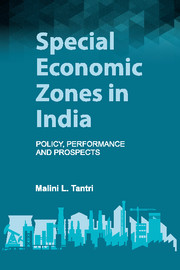Book contents
- Frontmatter
- Contents
- List of Tables, Figures, Charts and Maps
- Preface
- Acknowledgements
- Abbreviations
- 1 Introduction
- 2 Export Processing Zones to Special Economic Zones: Trajectories of Policymaking
- 3 China's Experience with Special Economic Zones under a Liberalized Regime – Highs and Lows
- 4 Performance of Special Economic Zones: Promises, Realizations and Paradoxes
- 5 An Assessment of the Fiscal Viability of Special Economic Zones
- 6 Special Economic Zones and the Question of Efficiency
- 7 Conclusions
- Bibliography
- Index
1 - Introduction
Published online by Cambridge University Press: 13 September 2017
- Frontmatter
- Contents
- List of Tables, Figures, Charts and Maps
- Preface
- Acknowledgements
- Abbreviations
- 1 Introduction
- 2 Export Processing Zones to Special Economic Zones: Trajectories of Policymaking
- 3 China's Experience with Special Economic Zones under a Liberalized Regime – Highs and Lows
- 4 Performance of Special Economic Zones: Promises, Realizations and Paradoxes
- 5 An Assessment of the Fiscal Viability of Special Economic Zones
- 6 Special Economic Zones and the Question of Efficiency
- 7 Conclusions
- Bibliography
- Index
Summary
Background
Special economic zones (SEZs) have a long economic pedigree in the context of India as well as other countries. From a global perspective, in today's context, SEZs are a modified version of the conventional export processing zones (EPZs), which again are a combination of two older instruments, viz., industrial estate/industrial park and free zone/free trade zone (FTZ) (World Bank, 1992). ‘Industrial estate’ refers to a geographical area allotted for industrial development. This concept emerged in the industrialized countries towards the end of the nineteenth century. However, FTZs were set up near airports or seaports areas, which were free from customs duties. These facilities were used for storing transaction goods. The fusion of two ideas, that is, industrial estate and FTZ, provided a basic framework for the emergence of EPZs, which were customized for the promotion of non-traditional exports. The world's first and full-fledged EPZ came up in Ireland in 1959 (World Bank, 1992), and thereafter, within a short span of time, the concept of EPZs spread all over the world, particularly the developing economies. India and Puerto Rico were at the forefront in popularizing EPZs as an instrument of trade. In India, the first attempt in this direction was made in 1964, as part of an inward looking trade strategy, followed by other developing countries such as Taiwan, Philippines, the Dominican Republic, Mexico, Panama and Brazil during the period between 1966–70 (Wong and Chu, 1985).
It is undeniable that neither India nor China invented or pioneered the SEZ concept; rather, it is fair to believe that it evolved over the centuries through permutations and combinations of different practices prevailing in many parts of the world. In fact, the number of EPZs increased sharply from 79 (spread over 25 countries) in 1975 to 6,000 (spread over 130 countries) by the end of 2006. The initial stimulus and growth of these zones could be attributed to the failure of the inward looking trade strategy that was in vogue in most of these economies. This was true particularly in the case of developing countries throughout Asia. The success of EPZs in later years was due to demonstration effect of the successful experience of the earlier zones, i.e., those established in the 1960s and 1970s.
- Type
- Chapter
- Information
- Special Economic Zones in IndiaPolicy, Performance and Prospects, pp. 1 - 10Publisher: Cambridge University PressPrint publication year: 2016



